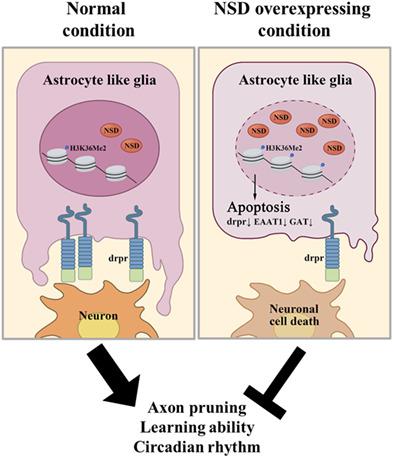Our official English website, www.x-mol.net, welcomes your feedback! (Note: you will need to create a separate account there.)
Overexpression of H3K36 methyltransferase NSD in glial cells affects brain development in Drosophila.
Glia ( IF 6.2 ) Pub Date : 2020-06-12 , DOI: 10.1002/glia.23867 Taejoon Kim 1 , Hyewon Shin 1 , Bokyeong Song 1 , Chihyun Won 1 , Hideki Yoshida 2 , Masamitsu Yamaguchi 2 , Kyoung Sang Cho 1 , Im-Soon Lee 1
Glia ( IF 6.2 ) Pub Date : 2020-06-12 , DOI: 10.1002/glia.23867 Taejoon Kim 1 , Hyewon Shin 1 , Bokyeong Song 1 , Chihyun Won 1 , Hideki Yoshida 2 , Masamitsu Yamaguchi 2 , Kyoung Sang Cho 1 , Im-Soon Lee 1
Affiliation

|
NSD1 is a histone methyltransferase that methylates the lysine 36 at histone H3. NSD duplication is associated with short stature, microcephaly, intellectual disability, and behavioral defects in humans. Ectopic overexpression of NSD, an NSD1 homolog in Drosophila, was shown to induce developmental abnormalities via apoptosis. In this study, to investigate the effects of NSD overexpression on Drosophila brain development, we first examined the typical NSD expression pattern in larval brains and found that endogenous NSD promoter activity was detected only in subsets of glial cells. Pan‐glial, but not pan‐neuronal, NSD overexpression induced apoptosis in larval brain cells. However, pan‐glial NSD overexpression also induced caspase‐3 cleavage in neuronal cells. Among the various glial cell types, NSD overexpression in only astrocytic glia induced apoptosis and abnormal learning defects in the larval stage. Furthermore, NSD overexpression downregulated the expression of various astrocyte‐specific genes, including draper (drpr), possibly owing to an indirect effect of NSD overexpression‐induced astrocytic apoptosis. Since drpr plays a role in axon pruning during mushroom body (MB) formation in Drosophila astrocytes, we examined the effect of astrocytic NSD overexpression on this process and found that it disrupted the clearance of γ‐neurons in the MB, subsequently inducing arrhythmic locomotor activity of the fly. Thus, these results suggest that aberrant NSD overexpression may cause neurodevelopmental disorders by interfering with crucial functions of astrocytes in the brain, underlining the importance of the tightly controlled astrocytic NSD expression for proper neurodevelopment.
中文翻译:

H3K36 甲基转移酶 NSD 在神经胶质细胞中的过表达影响果蝇的大脑发育。
NSD1 是一种组蛋白甲基转移酶,可将组蛋白 H3 的赖氨酸 36 甲基化。NSD重复与身材矮小、小头畸形、智力障碍和人类行为缺陷有关。果蝇中的NSD1同系物NSD 的异位过表达显示通过细胞凋亡诱导发育异常。在这项研究中,为了研究NSD过表达对果蝇大脑发育的影响,我们首先检查了幼虫大脑中典型的NSD表达模式,发现仅在神经胶质细胞亚群中检测到内源性NSD启动子活性。泛神经胶质,但不是泛神经元,NSD过表达诱导幼虫脑细胞凋亡。然而,泛神经胶质NSD过表达也会诱导神经元细胞中的 caspase-3 裂解。在各种神经胶质细胞类型中,NSD仅在星形胶质细胞中过表达会在幼虫阶段诱导细胞凋亡和异常学习缺陷。此外,NSD过表达下调了各种星形胶质细胞特异性基因的表达,包括draper ( drpr ),这可能是由于NSD过表达诱导的星形细胞凋亡的间接作用。由于drpr在果蝇蘑菇体 (MB) 形成过程中在轴突修剪中起作用星形胶质细胞,我们检查了星形胶质细胞NSD过表达对该过程的影响,发现它破坏了 MB 中 γ 神经元的清除,随后诱导了果蝇的心律失常运动活动。因此,这些结果表明异常NSD过度表达可能通过干扰大脑中星形胶质细胞的关键功能而导致神经发育障碍,强调了严格控制的星形胶质细胞NSD表达对正确神经发育的重要性。
更新日期:2020-06-12
中文翻译:

H3K36 甲基转移酶 NSD 在神经胶质细胞中的过表达影响果蝇的大脑发育。
NSD1 是一种组蛋白甲基转移酶,可将组蛋白 H3 的赖氨酸 36 甲基化。NSD重复与身材矮小、小头畸形、智力障碍和人类行为缺陷有关。果蝇中的NSD1同系物NSD 的异位过表达显示通过细胞凋亡诱导发育异常。在这项研究中,为了研究NSD过表达对果蝇大脑发育的影响,我们首先检查了幼虫大脑中典型的NSD表达模式,发现仅在神经胶质细胞亚群中检测到内源性NSD启动子活性。泛神经胶质,但不是泛神经元,NSD过表达诱导幼虫脑细胞凋亡。然而,泛神经胶质NSD过表达也会诱导神经元细胞中的 caspase-3 裂解。在各种神经胶质细胞类型中,NSD仅在星形胶质细胞中过表达会在幼虫阶段诱导细胞凋亡和异常学习缺陷。此外,NSD过表达下调了各种星形胶质细胞特异性基因的表达,包括draper ( drpr ),这可能是由于NSD过表达诱导的星形细胞凋亡的间接作用。由于drpr在果蝇蘑菇体 (MB) 形成过程中在轴突修剪中起作用星形胶质细胞,我们检查了星形胶质细胞NSD过表达对该过程的影响,发现它破坏了 MB 中 γ 神经元的清除,随后诱导了果蝇的心律失常运动活动。因此,这些结果表明异常NSD过度表达可能通过干扰大脑中星形胶质细胞的关键功能而导致神经发育障碍,强调了严格控制的星形胶质细胞NSD表达对正确神经发育的重要性。



























 京公网安备 11010802027423号
京公网安备 11010802027423号